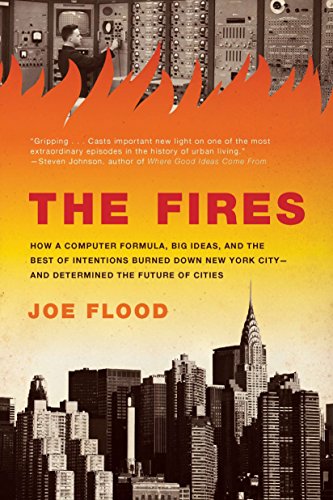The Fires: How a Computer Formula, Big Ideas, and the Best of Intentions Burned Down New York City--and Determined the Future of Cities / Joe Flood
| List Price: | |
Our Price: $16.00 | |
|
For Bulk orders
| |
|
Used Book Price: $5.18 | |
| The Fires: How a Computer Formula, Big Ideas, and the Best of Intentions Burned Down New York City--and Determined the Future of Cities / Joe Flood | |
| Publisher: Riverhead Books | |
| Availability:Usually ships in 24 hours | |
| Sales Rank: 912464 | |
|
Similar Books
Author Q&A with Joe Flood
Joe Flood is a journalist who has spent years researching the facts and implications of the epidemic of fires that swept through New York City in the 1970s.

Q: The subtitle of your book is “How a Computer Formula, Big Ideas, and the Best of Intentions Burned Down New York City – and Determined the Future of Cities.” That’s quite a mouthful! What gives this story such broad and lasting significance?
A: Yeah, that’s sort of the joke—it took me five years to research and write the book, and about 4 years and 11 months before we settled on a subtitle. It is a mouthful but we were trying to figure out something that gave a sense of the different areas the book hits on. At heart it’s a narrative about a city that was burning down and going bankrupt and the men and women of the fire department, city government and burning neighborhoods that dealt with those fires. But to tell that story I needed to dig into all kinds of other fields. Urban planning, economics, the history of computer modeling, political reform movements. The fires were the result of a swirling confluence of things and I figured the title should reflect that—even if it is a mouthful!
Q: Are the number crunchers the bad guys?
A: In a lot of ways the whole point of the books is that there are no ‘bad’ guys. There’s an old line attributed to Napoleon to the effect that when something goes wrong it’s more likely to be caused by incompetence than malice. And with the fires, almost everyone involved really wanted to do good (hence the “best of intentions” part of the subtitle). But that said, the number crunchers made mistakes—understandable mistakes, but ones with serious real world consequences which they still refuse to acknowledge. To this day RAND analysts say that there is nothing wrong with a model that says traffic has no impact on how quickly a fire company can respond to a fire. When I do readings or mention that to people—particularly anyone who has ever been to New York—they laugh. Of course traffic affects how quickly you drive through city streets. But that’s one of the problems with modeling the real world—there are so many variables at play that it’s almost impossible to factor everything in.
Q: Who are the heroes?
A: Certainly the firefighters who dealt with the burnout. For all the politics and bureaucracy and big ideas I write about in the book, at the end of the days it’s the firefighters who were risking their lives to save people. And not just risking their lives at the time. The fires weren’t that long ago, 30-40 years, and yet you talk to firefighters from that time and so many of their friends are now gone. Heart attacks, lung cancer, emphysema, strokes—the consequences of years spent sucking smoke night after night.
And the other heroes of course are the people who lived in burned out areas like the South Bronx and Harlem. Not just for suffering through that period, but more importantly for rebuilding. Churches, community groups, housing programs and just average people have rebuilt housing and businesses. New York is a place of vitality and constant change, and they brought that back to communities that were left for dead by most of the experts and academics and politicians and planners.
Q: Did the number crunchers triumph? Who or what drives government today?
A: Well you know the old saying, the more things change, the more they stay the same. Ultimately government today is driven by the same competing factors it’s always been driven by—money, power, altruism, self-interest. What’s changed though are the tools we use to express those drives. More and more we rely on technocrats to make decisions for us. Congress waited on pins and needles for the Congressional Budget Office to project how much Obama’s healthcare bill would cost or save the government before voting on it; economists and bureaucrats dole out billions in bailout money here and abroad based on a handful of studies and projections; management consultants and budget commissions are coming up with ways to save money and cut services; experts in highly technical fields which the public has little to no understanding of determine the likelihood of an oil rig failing or a terror threat occurring. So in that sense yes, the number-crunchers—whether they are Wall Street quantitative modelers or government accountants or high-flying economists—really do control a lot of power despite their checkered history.
Q: At a moment when not only New York City but many state and local governments are once again in fiscal crisis, what does your book tell us about how to tighten the belt without once again courting disaster?
I think it’s all about balancing the power and strengths that centralized technocrats and efficiency experts have with the more local knowledge of people who actually live and work in the places that will be affected by cuts. I’m not saying you can’t have budget cuts—for decades now this country has refused to either cut services or raise the tax revenue needed to pay for them, and it’s about time we faced up to that fact. But sometimes cutting certain programs can be more expensive than leaving them intact. I read an article the other day about city and state-funded day care programs that are being shut down, and a lot of single moms who are having to cut back on working, and in turn are relying more on food stamps, welfare and other government programs. That’s a great example of a budget cut that looks good on paper, but ends up costing more in the long, and even in the short-run. I’d also say that when it comes to cutting budgets, more attention needs to be paid to savings made by cutting fancy programs and upper-level management. The FDNY right now is looking at closing as many as twenty fire companies for a savings of about $30-$40 million dollars. But no one has said a word about cutting the billions being spent on fancy new computer and communications technology, or the ranks of expensive, upper-echelon chiefs and advisers at fire department headquarters. But those with the gold make the rules…
Q: What are the pitfalls of a “city in crisis” narrative like the one that captured Mayor Lindsay in the 1970s? How do we avoid falling prey to it as we face hard times?
A: Any time a politician runs a campaign based on the idea that a city, state or country is “in crisis,” he or she is going to have a tough time transitioning from campaigning to governing. People in crises have to make snap-judgment decisions, they have to think in the short-term, they can’t afford to be thoughtful or circumspect or even empathetic. That’s not a good way to run a government. It makes us feel important to run around saying we’re in a crisis, that the world is changing forever, that this is the first or last time people have faced the challenges we face today. But it’s usually not true, and more importantly, it’s almost never helpful to have such a self-centered approach to politics. Obviously crises occur and they need to be dealt with—be it anything from the Depression and World War II to Ronald Reagan and Tip O’Neill hashing out a social security compromise to the BP oil spill in the Gulf. But history is very long, and any government that wants to be around for much of it should worry more about producing quiet results than about hyping the latest crisis.
Q: This is a meticulously researched book that required a lot of old-fashioned reporting. What’s the most surprising thing you uncovered?
The most surprising thing was just how big the disconnect is between the people who make decisions, those who carry them out, and those affected by the consequences of those decisions. This isn’t really surprising, we all know there’s an information and experience gap there. But it really brought things home for me to take an issue or event in the book and ask people from different backgrounds and perspectives to talk about it and see how broad the reactions were. It’s a reminder of how hard governing can be—the way a policy looks on paper and the way it is actually implemented and plays out can be so different.
Now you can buy Books online in USA,UK, India and more than 100 countries.
*Terms and Conditions apply
Disclaimer: All product data on this page belongs to
 .
.No guarantees are made as to accuracy of prices and information.










